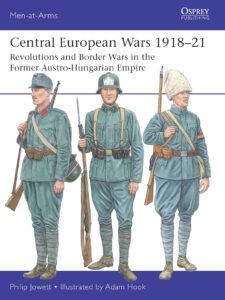Philip Jowett, Central European Wars 1918-21 (Osprey, 2025)
When peace came in November 1918, the war to end all wars had finally ended. At least that is how the story goes for most of us. But the war that destroyed the Austro-Hungarian empire unleashed a tsunami of revolutions and conflicts across eastern Europe and the Balkans. In this volume of Osprey’s Men-at-Arms series, Philip Jowett surveys the men who fought those wars, what they wore and how they were armed, while providing a flavour of the main events in the period 1918 to 1921.
Jowett introduces us to the chaos that enveloped the Habsburg Empire after the armistice, helpfully providing a brief chronology. Then we meet the major players – Austria, Czechoslovakia, Hungary, Romania, and the Kingdom of Serbs, Croats, and Slovenes – and learn how they organised their armies. Jowett describes how these armies depleted the stores of the former empire for their weapons, uniforms, and equipment, though the Romanians and Serbs, Croats, and Slovenes benefitted from the support of the former Allied powers. Jowett moves on to the major operations, including the Carinthia War, Romania’s invasion of Hungary, the Polish-Czechoslovak War, the Hungarian-Czechoslovak War, and other conflicts involving the busy Hungarians.
This is a slim book that appeals to a niche readership. But if, like me, your gateway into a historical period is through understanding the human experience, however pretentious that might sound, then wee survey books like this can lead to more in-depth reading on the subject. Jowett’s text is an easy read and clarifying on a highly complex series of events. He is aided by Osprey’s graphic illustrations of soldiers and an excellent array of contemporary photographs. I expect that Jowett’s book will be well received by his target audience.
